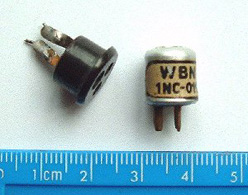
East Germany is the colloquial name for the former German Democratic Republic (GDR), or in German, the Deutsche Demokratische Republik (DDR). This was the socialist state established in 1949 in the Soviet zone of occupied Germany and in East Berlin. Early semiconductor research in this country was dominated by one organisation, the Werk für Bauelemente der Nachrichtentechnik (WBN), or in English the "Works for components of telecommunications". WBN appears to have operated in two locations:
Early WBN transistors bear the identifying letters WBN. Later ones are marked HWF, and some IHT, to reflect changes in the names of the above facilities. Even later examples have no manufacturer name but instead just bear the logo shown on the right.
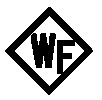
WBN appears to be related to another DDR semiconductor factory, the "Werk für Fernmeldewesen" (WF), again a "works for telecommunications", located in Berlin-Köpenick, Ostend Street 1-5. This opened in 1948, became a VEB in 1953/4, and changed its name in 1960 to "VEB Werk für Fernsehelektronik" the "Publicly Owned Operation works for television electronics", although the logo WF was retained. WF specialised in manufacturing diodes, whereas WBN made transistors.
Later, another organisation, the Röhrenwerk "Anna Seghers" Neuhaus a.R., (named after a famous German woman writer) abbreviated as RWN, made germanium power transistors, some of which I show below. They have a logo of a thermionic tube/valve.
I have also come across an article on the Web that shows that VEB Funkwerk Erfurt (FWE) produced germanium power transistors for a short time. It is unclear whether any were ever more than just protytpes. More details below.
I have put this description together from various sources written in German which are unclear and possibly contradictory. The above may therefore be inaccurate and it is certainly not complete. If you know more, please

Like most countries the GDR/DDR began with production of point-contact germanium diodes. They included a number in green cylindrical cases in several shapes such as types DD and GDT, and series MDnnn and RDnnn. I am seeking examples of these early DDR germanium diodes, if you know how I can obtain any, please
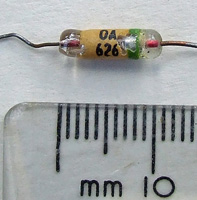
In the late 1950s and early 1960s WF made a number of series of point-contact germanium diodes numbered in the Western OA series:
My image shows an OA626.
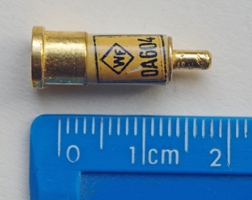
WF also made point-contact germanium radar diodes in typical cartridge cases, numbered OA601 to OA605, in the 1960s. My image shows an OA604.
WBN made cartridge diodes in smaller cases. I am only aware of two: the OA500 and OA513. I would be interested in obtaining examples of these, or data about them. If you know about them, please
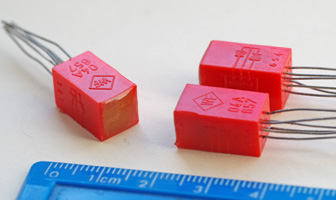
This extraordinary construction is the O4A657 quadruple diode, or more accurately, dual diode pair. I have a 1962 data booklet, "RFT Halbleiter Bauelemente", that includes it. You can see that the red cuboid is filled with a different coloured plastic, so I suspect it just contains four glass miniature diodes. They are arranged as two pairs: each pair is wired in series with one common central connection, giving three leads per pair, six leads in total. The RFT component catalogue describes it as a (ring) modulator.
WF also produced two other compound devices. The OAA646 and 2OA646 diode pairs seem to be pairs of OA646 packed together.
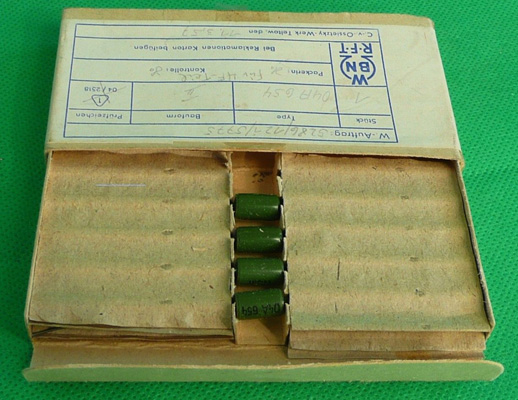
This box and the four separate diodes in it are marked O4A654 which implies they form a quartet, although I'm unsure how this is different from individual OA654 diodes. I would be interested in obtaining data about this. If you know how I can get some, please
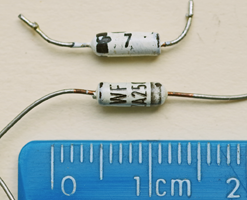
In 1954 WF began production of silicon point-contact diodes in two series:
I would be interested in obtaining examples of the OA900 series. If you know about them, please

WBN also made silicon power Zener diodes numbered ZL910 with a variety of suffixes denoting voltage, e.g., ZL910/6 for a nominal 6V 250mA Zener. I would be interested in obtaining examples of these. If you know about them, please
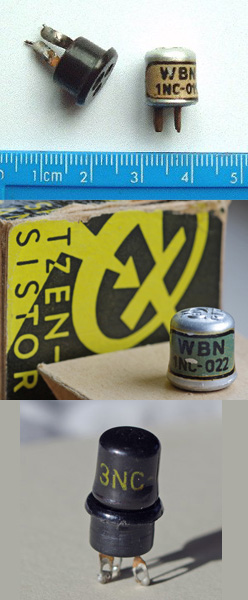
Things get very interesting in 1954/55/56 when WBN produced four series of point-contact germanium transistors:
- 1NC-020 Vce=-50V fT=1MHz - AF amplifier
- 1NC-021 Vce=-50V fT=3MHz - AF amplifier
- 1NC-022 Vce=-50V fT=6MHz - AF amplifier, shown on the right
All these types use a squat cylindrical plug-in cartridge with a bespoke socket. The earliest are unpainted with labels as the 1NC-011 in the upper part of the image shows, but later types are painted black with the part number printed on them, such as the 3NC-010 shown in the lower part (plugged into its socket).
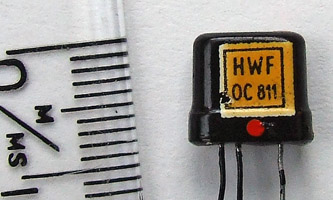
I'm unsure of the exact chronology, but in about 1957 WBN started to manufacture germanium junction transistors. Their first series was numbered OC81x:
Initially these bore the WBN lettering but later that changed to HWF for "HalbleiterWerk Frankfurt" (Frankfurt/Oder component works). The series extended from OC810 to OC818 and all were AF types. These can be found in some early DDR transistor radios from about 1960, such as the Sternchen.
I am looking for OC81x types marked WBN, and specifically OC812 with any markings. If you know how I can obtain any, please
Ich suche nach OC81x Typen WBN markierte und OC812 speziell mit Kennzeichnungen. Wenn Sie wissen, wo ich jede bekommen, bitte kontaktieren Sie mich.
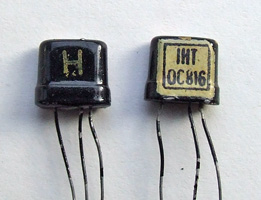
The OC81n series also has examples with the lettering IHT such as this OC816. This stands for the "Institut für Halbleitertechnik" in Teltow which was founded in 1960, and seems to be a renaming and probably a promotion of the "Carl von Ossietzky" laboratory. I'm unsure of the exact significance of this so if you can explain this chronology, please
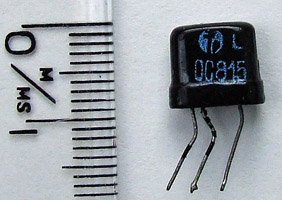
Some of the OC81n series devices have the part number and HFO logo printed on them rather than a decal, such as this OC815. Presumably these are later production.

Some of the OC81n series types have variants, marked as the LC series, using the same oval TO-22 can and also an elongated cylindrical can. These were released as 'hobbyist' types and clearly are out-of-spec examples. The only types that I know to exist are LC810 and LC815. I have neither of them and am interested to obtain examples. If you have any for sale or exchange, or have any original datasheets for them, please
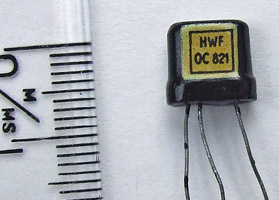
By 1960 there was an OC82x series that also started in the oval outline.
These are a mixture of medium-power (100mW) germanium PNP AF amplifier and low-frequency-switching transistors. There is also a 'hobbyist' LC824, which is an AF type with looser ratings.
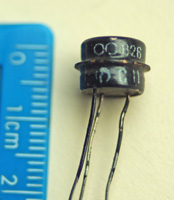
They switched later to a TO-9 (?) can resembling the
English GEC GET88x series.
I am looking for OC82x series devices and the LC824, if you have any, please
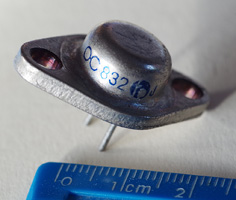
By 1960 there are also power types in TO-66 encapsulation:
My image shows an OC832. I would be very interested to obtain examples of these, especially any with WBN decals/printing on them. If you have any for sale or exchange, or have any original datasheets for them, please
Es gab auch frühe Leistungstransistoren, die OC830 zu OC838 , von denen einige LD83x Äquivalente hatte. Ich bin sehr daran interessiert, Beispiele für diese zu erhalten. Wenn Sie eine zum Verkauf oder Austausch haben oder haben keine Originaldatenblätter für sie , bitte kontaktieren Sie mich.
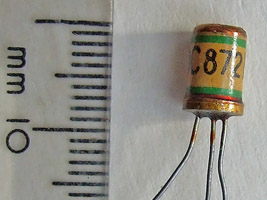
RFT Halbleiter Bauelemente from September 1962 lists an OC87n series that contains AF and IF/RF types:
These use TO-18 cans, and some also use painted TO-44 cans like this OC872.
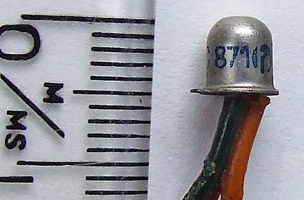
The OC871 is found in both forms, my TO-18 example bears the WBN logo shown above.
I am seeking examples of the LF871 as well as painted TO-44 versions of any of these transistors. If you can provide any, please
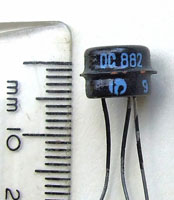
RFT Halbleiter Bauelemente from September 1962 also lists the WBN OC88x series, confusingly using the same TO-9 outline and series numbers as GEC in England although different in prefix:
These are low-power germanium PNP RF transistors for use as mixers/oscillators and amplifiers in radio and TV applications.
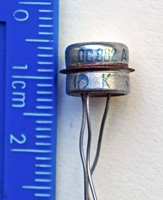
They seem to have been first produced in painted cans, and then later in unpainted cans with an A suffix as shown.
I am looking for OC88x and LF88x series devices, if you have any, please

WBN made further hobbyist types, probably out-of-spec production examples, in the LA series.
I am looking for any of these, if you have any, please

There is an interesting article on the Web that describes prototype germanium power transistors made by WBN : the GD210-230 series. They were not commercialised. Needless to say, I would be very interested to obtain examples. If you know how I can obtain any, please

I don't have definitive proof, but possibly the first silicon transistors made in the DDR were the series OC920 - 923 of PNP alloy-junction types made by IHT in about 1964. They use a standard TO-5 can.
I am looking for any of these, if you know how I can obtain any, please
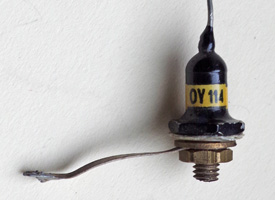
The DDR also made rectifier diodes in three series:
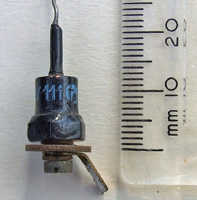
These diodes have later versions with GY numbering and more modern packaging (see next section). My images show an OY114 and a GY111, both made by HWF.
I possess no examples in the OY100 and OY120 series. If you know how I can obtain any, please
The magazine "Funkamateur Sonderausgabe" in 1964 published a short article stating that from 1 January 1964, most DDR semiconductors would be named following a standardised system. Devices from these series, which bear an approximate correspondence to Pro-Electron series apart from the initial letter 'G' rather than 'O' or 'A', were made in several countries as well as the DDR (such as Czechoslovakia and Hungary):
The convention adopted is: the initial letter is
The second letter is:
The article also lists a correspondence between old types and the new ones, for instance:
As part of the change, the idiosyncratic older package types were mostly replaced by tall TO-18-long cans. The new types are therefore less interesting than the earlier ones, but many are still germanium. If you know which organisation in Eastern Europe defined these new series, please
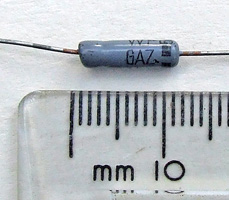
Here is a GAZ14a. The letters Y and Z apparently can be appended after the A denoting a diode although the magazine article does not mention this. I do not know their significance, but a Z in this position does not mean a Zener.
I possess little data for the GA, GAY and GAZ series of diodes. If you know how I can obtain any, please
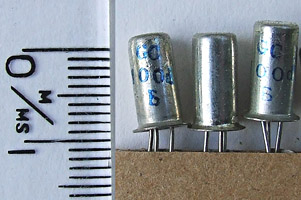
This image shows some GC100d transistors , manufacturer unknown.
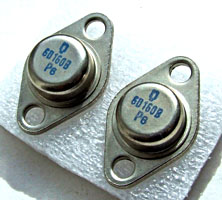
This image shows a pair of GD160 made by RWN, the Röhrenwerk "Anna Seghers" Neuhaus a.R., VEB.

There is an interesting article on the Web that describes how the VEB Funkwerk Erfurt (FWE), which was known for its extensive tube production, was made redundant by a rationisation of the DDR industry at the end of the 1950s. It briefly switched its focus to the development of germanium power transistors. This does not seem to have been commercially successful, but the article shows that they produced at least one transistor, the OC846A, and I expect that there may be others. Needless to say, I would be very interested to obtain examples. If you know how I can obtain any, please
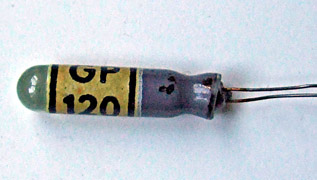
This delightfully hand-made looking device is a GP120 germanium photodiode made by WF. They made a series of four, GP119 to GP122.
WBN went on to manufacture silicon transistors and ultimately integrated circuits. An interesting description of the company can be found in a declassified CIA document dated 19 October 1967, entitled "LEVEL OF TECHNOLOGY AND PRODUCTION OF SEMICONDUCTORS IN THE USSR AND EAST EUROPE". This states:
"East German semiconductor research and development is coordinated by the Institute for Semiconductor Technology of the East German Academy of Sciences at Teltow. Part of the activity of this institute is devoted to acquiring and copying Free World semiconductor devices. East Germany copies and reproduces high frequency transistors that are embargoed by COCOM and imports low frequency general purpose types that are not embargoed. These can be imported at prices below the level of domestic manufacturing costs and are more reliable than domestic transistors.
Tbe East German semiconductor Industry has been built on the basis of Western technology. The main semiconductor plant at Frankfort/Oder, for example, attempted to begin transistor production on the basis of Soviet technology which proved to be faulty and which the East Germans later learned had been abandoned in the USSR. Frankfurt/Oder was re-equipped by about 1963 with production machinery from the UK (this machinery, purchased at a 50 percent premium, turned out to be obsolete; reject rates on the order of 80 percent were reported). East Germany continues to import some semiconductor manufacturing equipment from the Free World, but is increasingly developing its own because of the difficulties COCOM imposes on procurement from the West".
Of course, the world has changed a lot since that was written. I believe that WBN/HWF/IHT suffered major change subsequent to German reunification in 1990, but I have no details of this. There is a Web page that gives some history, showing the decline from 8500 staff in 1978 to 44 in 2001.
